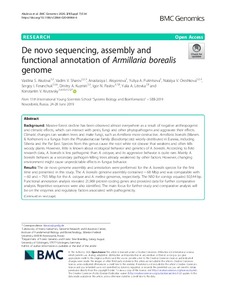De novo sequencing, assembly and functional annotation of Armillaria borealis genome
Скачать файл:
URI (для ссылок/цитирований):
https://elib.sfu-kras.ru/handle/2311/137954Автор:
Akulova Vasilina S.
Sharov Vadim V.
Aksyonova Anastasiya I.
Putintseva Yuliya A.
Oreshkova Natalya V.
Feranchuk Sergey I.
Kuzmin Dmitry A.
Pavlov Igor N.
Litovka Yulia A.
Krutovsky Konstantin V.
Дата:
2020Журнал:
BMC genomicsКвартиль журнала в Scopus:
даКвартиль журнала в Web of Science:
даСтатья из журнала.
Аннотация:
BACKGROUND: Massive forest decline has been observed almost everywhere as a result of negative anthropogenic and climatic effects, which can interact with pests, fungi and other phytopathogens and aggravate their effects. Climatic changes can weaken trees and make fungi, such as Armillaria more destructive. Armillaria borealis (Marxm. & Korhonen) is a fungus from the Physalacriaceae family (Basidiomycota) widely distributed in Eurasia, including Siberia and the Far East. Species from this genus cause the root white rot disease that weakens and often kills woody plants. However, little is known about ecological behavior and genetics of A. borealis. According to field research data, A. borealis is less pathogenic than A. ostoyae, and its aggressive behavior is quite rare. Mainly A. borealis behaves as a secondary pathogen killing trees already weakened by other factors. However, changing environment might cause unpredictable effects in fungus behavior. RESULTS: The de novo genome assembly and annotation were performed for the A. borealis species for the first time and presented in this study. The A. borealis genome assembly contained ~ 68 Mbp and was comparable with ~ 60 and ~ 79.5 Mbp for the A. ostoyae and A. mellea genomes, respectively. The N50 for contigs equaled 50,544 bp. Functional annotation analysis revealed 21,969 protein coding genes and provided data for further comparative analysis. Repetitive sequences were also identified. The main focus for further study and comparative analysis will be on the enzymes and regulatory factors associated with pathogenicity. CONCLUSIONS: Pathogenic fungi such as Armillaria are currently one of the main problems in forest conservation. A comprehensive study of these species and their pathogenicity is of great importance and needs good genomic resources. The assembled genome of A. borealis presented in this study is of sufficiently good quality for further detailed comparative study on the composition of enzymes in other Armillaria species. There is also a fundamental problem with the identification and classification of species of the Armillaria genus, where the study of repetitive sequences in the genomes of basidiomycetes and their comparative analysis will help us identify more accurately taxonomy of these species and reveal their evolutionary relationships.

